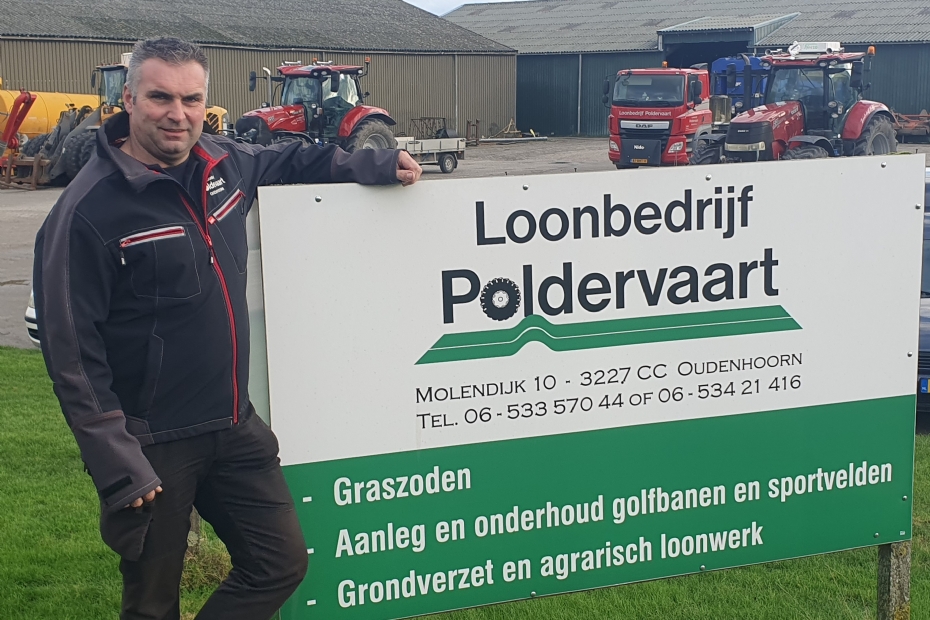Sand slits for optimal drainage |
|
|
|
|
 |
| 162 sec |
Drainmaster keeps the course playable all year round
Golf course Landgoed Bergvliet, located a stone's throw from Breda and Oosterhout, previously struggled with waterlogging. Thanks to a large-scale drainage system, the course is now playable year-round. The Drainmaster plays a key role in this.
"The Drainmaster has the great advantage that a full renovation of the course is not necessary. You can apply this method to an existing golf course without completely removing the top layer. This means the course is playable again within a few days, significantly reducing costs and inconvenience," says Perry van Korven, head greenkeeper at Golf course Landgoed Bergvliet.
Winterproof golfing
It's winter, yet golfers are actively playing at Golf course Landgoed Bergvliet. Perry van Korven, head greenkeeper, explains that this wasn't always the case: "When I started here ten years ago, some fairways were less playable during heavy rainfall. In winter, these holes were shortened or closed. The problem? There was hardly any drainage. That's when I got in touch with Loonbedrijf Poldervaart. Owner Leo Poldervaart had experience with the construction and renovation of sports fields and golf courses. Together, we devised a renovation plan where some sections were raised by as much as 50 centimeters, allowing us to be further above the groundwater level."
 | | Leo Poldervaart |
|
|
Installing the drainage system
Installing a drainage system on a golf course is a specialized task, explains Leo Poldervaart: "You have to consider elevation differences when designing your drainage system. At Landgoed Bergvliet, we first used our drainage machine to dig trenches for the pipe system. For top-layer drainage, we used the Drainmaster, as it doesn't require removing the entire top layer. The machine creates slits 25 centimeters deep and 4 centimeters wide, ensuring effective drainage. We apply this system gradually on the fairways and foregreens. It's a large-scale operation, as in addition to the Drainmaster, we use two sand-filling carts, two tipper trucks, and a crane to load the sand." The two extra filling carts are essential, as the Drainmaster's own sand bunker can only fill about 100 meters.
|
|
"This allows the slits to grow over more quickly without compromising drainage."
| |
|
Drainmaster operation
The Drainmaster is designed for top-layer drainage. Driven by a tractor, the machine digs three sand slits, spaced 50 centimeters apart, perpendicular to the existing drainage. The material from the top layer is transported via a conveyor belt to a tipper truck. Once the slits are dug, the Drainmaster fills them under high pressure with drainage sand. The machine's rear wheels then firmly press the sand down.
Regrowth and topdressing
To promote grass regrowth, Poldervaart mixes the drainage sand lightly with compost. "This allows the slits to grow over more quickly without compromising drainage. The removed soil was used for topdressing the slits. Finally, I use Vertidrain ice-cream cone tines, which create holes in the shape of an ice-cream cone. After filling them with drainage sand, with an average grain size of 350 micrometers, a pattern of draining sand cones forms across the course."
|
|
"You can apply the method without completely removing the top layer."
| |
|
The major benefits
Van Korven previously tested a machine that pushed the soil aside and created channels of 1 to 1.5 centimeters. "I found that far from ideal because the soil on the sides compacted, and the sand mixture was minimal. As a result, the sand mixed with the soil over a few years, causing the drainage problem to return quickly.
The Drainmaster replaces the existing soil with drainage sand. The Drainmaster's slits are wider and deeper, providing a solution for the next 25 years. This system also reduces maintenance costs. The difference before and after treatment with the Drainmaster is enormous. The greatest benefit is that we can now golf all year round, rain or shine."
 | | Stuart Blyth, head greenkeeper Cleydael Golf & Country Club |
|
|
The clay at Cleydael
Near Antwerp lies the wooded Cleydael Golf & Country Club. This golf course features eighteen holes with the historic Cleydael Castle as its backdrop. The clay-rich top layer causes drainage issues on the course. Player and machinery traffic further compacts the clay, leading to water pooling on the course. To address this problem structurally, head greenkeeper Stuart Blyth began a trial with the Drainmaster on one of the fairways last November: "The main drainage system consists of a 100-millimeter perforated pipe, filled with 60 centimeters of sand and covered with 10 centimeters of soil. This system forms the foundation of our drainage concept. We chose the Drainmaster because it provides more effective access to the main drainage system."
Drier and more stable
"The initial results are promising," says Blyth. "The fairway remains drier and more stable, allowing us to use blowers and other equipment more frequently. Since the trial took place at the end of the growing season, regrowth is still limited. In the spring, we will treat the sand slits with topdressing and reseeding. After that, we will consider implementing this method on all fairways."
This article was previously published on February 5, 2025, on the Greenkeeper website.
| LOG IN
with your email address to respond.
|
|
|
| There are no comments yet. |
|
| |
Anyone can place small ads for free through their own account.
Place a free ad
|
|
|
|